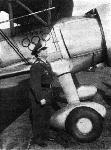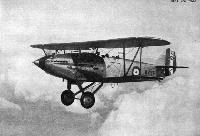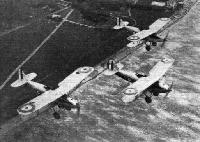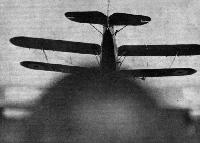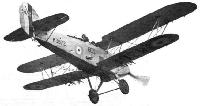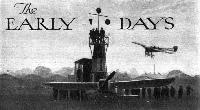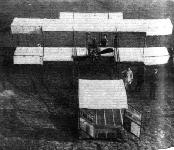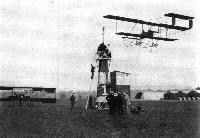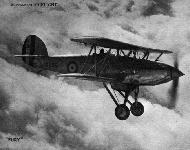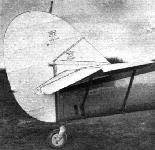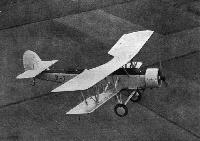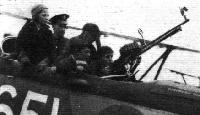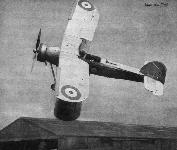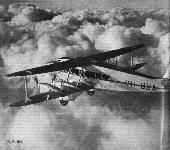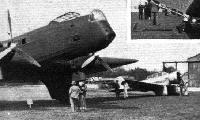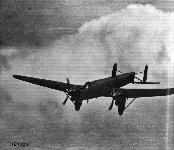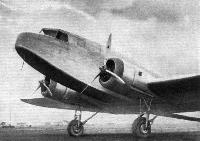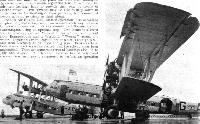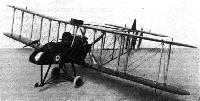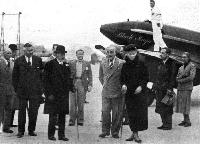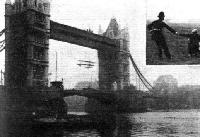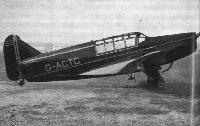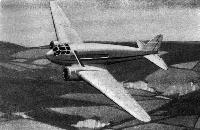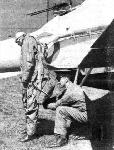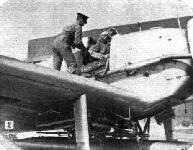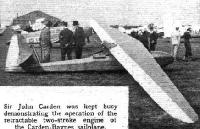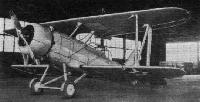Фотографии
-
Carrying a gun in the nose of its nacelle, the D.H.2 pusher (100 h.p. Gnome Monosoupape) was very effective against the Fokkers.
Самолёты на фотографии: De Havilland D.H.2 - Великобритания - 1915
-
"A DRESS REHEARSAL": Some D.H.9a's of No.39 Bombing Squadron carrying out evolutions over Hendon.
The D.H.9A (400 h.p. Liberty engine), which was introduced in 1918 and remained in extensive use until a few years ago, may be regarded as one of the typical intermediate types between the early and the modern military aeroplanes.Самолёты на фотографии: De Havilland D.H.9A - Великобритания - 1918
-
AMUSING - AND INSTRUCTIVE. Herr Ernst Udet, the German pilot, with the Curtiss "Cyclone-Hawk" which was acquired for aerobatic displays - and, possibly, as an example of a modern fighter.
Самолёты на фотографии: Curtiss F11C / Hawk II / BFC-2 / Model 35 - США - 1932
-
QUEER BEASTIES FROM AMERICAN WATERS. A flight of Curtiss BF2C-1's from America's latest aircraft carrier Ranger. These peculiar-looking retractable-undercarriage biplanes are fitted with 700 h.p. "Cyclones" giving a maximum speed of well over 200 m.p.h., and, apart from their employment as fighters, are used extensively as dive bombers, when they carry nearly 500 lb. of projectiles apiece.
Самолёты на фотографии: Curtiss F11C-3 / Hawk III / BF2C-1 / Model 68 - США - 1933
-
Регистрационный номер: K2124 Самолёты на фотографии: Hawker Hart - Великобритания - 1928
-
EMPIRE AIR DAY: A flight of "Harts," from Eastchurch, loaded with 8 1/2 lb. practice bombs, make for the bombing target moored off Leysdown.
Самолёты на фотографии: Hawker Hart - Великобритания - 1928
-
Самолёты на фотографии: Gloster Gauntlet - Великобритания - 1929Hawker Hart - Великобритания - 1928
-
The photograph illustrate the attack of a flight of "Gauntlets" on a flight of "Harts." In the picture one fighter is seen on the left, coming up behind and below the starboard bomber, while two "Gauntlets," one behind the other, are stalking the port bomber which appears on the right of the picture.
Самолёты на фотографии: Gloster Gauntlet - Великобритания - 1929Hawker Hart - Великобритания - 1928
-
Another view of the attack by the "Gauntlets," which shows still more clearly one fighter tackling the starboard bomber while two approach the port bomber. If their attacks are successful the leading "Hart" will be left alone to deal with all three fighters.
Самолёты на фотографии: Gloster Gauntlet - Великобритания - 1929Hawker Hart - Великобритания - 1928
-
This remarkable photograph shows the attack from the fighter's point of view. The head of the fighter pilot is naturally out of focus. He has now got into position in the blind spot below the "Hart" and is about to riddle it with bullets from his two Vickers guns.
Самолёты на фотографии: Gloster Gauntlet - Великобритания - 1929Hawker Hart - Великобритания - 1928
-
The photograph illustrate the attack of a flight of "Gauntlets" on a flight of "Harts." In the picture is shown the view of the gunner in the port "Hart" as the two fighters approach him. He dare not fire at them for fear of hitting his own fin, but must trust to cross fire from the "Hart" on his starboard side.
Самолёты на фотографии: Gloster Gauntlet - Великобритания - 1929Hawker Hart - Великобритания - 1928
-
Another view from the gunner's cockpit in the port "Hart." Note how the fighter pilots are shielded by their "Mercury" engines.
Самолёты на фотографии: Gloster Gauntlet - Великобритания - 1929Hawker Hart - Великобритания - 1928
-
Регистрационный номер: K3872 The gunner in a "Hart," disregarding a fighter which is under his own tail, is aiming his gun at a "Gauntlet" which is attacking the "Hart" on his left. The bomber formation relies almost entirely upon cross-fire.
Самолёты на фотографии: Hawker Hart - Великобритания - 1928
-
Самолёты на фотографии: Bleriot Bleriot-XI - Франция - 1909
-
This machine was designed by the Royal Aircraft Establishment. The B.E.2C was an automatically stable tractor biplane with 90 h.p. R.A.F. engine.
Самолёты на фотографии: RAF B.E.2c/B.E.2d - Великобритания - 1914
-
Регистрационный номер: K2493 The end of the sprint - the pilots reaching their "Bulldogs," which are waiting with engines warmed ready to start.
Самолёты на фотографии: Bristol Bulldog - Великобритания - 1927
-
A Hamilton Standard controllable-pitch airscrew on a British engine. The Bristol "Mercury VI" has been officially approved for use with this airscrew, following 50 hours bench tests and 50 hours flying tests. It is here seen on a "Bulldog.''
Самолёты на фотографии: Bristol Bulldog - Великобритания - 1927
-
Bristol "Bulldog IV"
Самолёты на фотографии: Bristol Bulldog - Великобритания - 1927
-
The Vickers "Gun Bus" did much good work during the early part of the war. It was fitted with a Gnome rotary engine.
Самолёты на фотографии: Vickers FB.6 - Великобритания - 1914
-
Early type: An early Martinsyde monoplane (50 h.p. Antoinette). Note the wind shield in front of the control wheel.
Самолёты на фотографии: Martin & Handasyde Model 2/3/4/5 - Великобритания - 1910
-
The Henry Farman biplane (50 h.p. Gnome rotary engine) on which Louis Paulhan won the London-Manchester Race in 1910.
Самолёты на фотографии: Farman Farman-III - Франция - 1909
-
Регистрационный номер: F9029 One of single-seater fighters which beat the "Albatros" and Fokker Triplane was the S.E.5A with 240 h.p. Wolseley "Viper."
Самолёты на фотографии: RAF S.E.5 - Великобритания - 1916
-
Hon. C. S. Rolls with his Wright biplane at the first International Aviation Meeting at Bournemouth, 1910, where he met with a fatal accident whilst taking part in the landing competition. His death robbed Great Britain of one of its most honoured and enthusiastic pioneer airmen and balloonist. He was one of the first group of "experimenters" who began flying at the Royal Aero Club's aerodrome at Eastchurch.
Самолёты на фотографии: Wright Wright III / Wright A / Military Flyer - США - 1905
-
LOOKING BACK: A typical Saturday afternoon scene at Hendon in 1914. Pierre Verrier is seen trying to touch with his wing tip the tin discs on top of No. 1 pylon. Another attempt succeeded. Standing on the ground is a Grahame-White "box kite"; Note the drooping ailerons.
Самолёты на фотографии: Grahame-White biplane / School 'bus - Великобритания - 1912Maurice Farman MF.7 Longhorn - Франция - 1912
-
A 1913 Breguet (Salmson water-cooled radial engine), one of the first all-metal aeroplanes and the first with single-spar wing construction.
Самолёты на фотографии: Breguet 3 - Франция - 1910
-
FOR SERVICE IN SOUTH AMERICA: The first of six new high-speed amphibians which are to be used along the Amazon River from Para to Manaos and in other sections of the Pan American Airways system.
Самолёты на фотографии: Fairchild Model 91 Baby Clipper - США - 1935
-
Самолёты на фотографии: Fairchild Model 91 Baby Clipper - США - 1935
-
A Bristol "Box kite," also with Gnome engine. In this machine the occupants were unprotected.
Самолёты на фотографии: Bristol Boxkite - Великобритания - 1910
-
Регистрационный номер: K3500 EFFICIENT DISTRIBUTION OF ARMAMENT. On the Handley Page "Heyford" Night Bomber one gun is carried in the nose and two midway between the wings and tail. Of these, one is mounted in the "dustbin" seen extended.
Самолёты на фотографии: Handley Page Heyford / H.P.38 / H.P.50 - Великобритания - 1930
-
Регистрационный номер: J9185 The Boulton Paul "Overstrand" with two Bristol "Pegasus" engines: A substantial development order for these machines has been placed by the Air Ministry. It has not yet been decided which squadron or squadrons will receive this very formidable medium bomber.
J9185 was another Sidestrand conversion to Overstrand configuration.Самолёты на фотографии: Boulton Paul Overstrand / P.75 - Великобритания - 1933
-
In the photograph the large top 'plane extensions of the Henry Farman are better shown than in the previous photograph. Note king post bracing on top.
Early military flying depended largely upon two Farman types, the Henry (shown) and the Maurice "Longhorn". The former had an 80 h.p. Gnome and the latter a 60 h.p. Renault engine.Самолёты на фотографии: Farman HF.15 / 16 / 20 / 22 - Франция - 1912
-
Early type: The Dunne automatically-stable biplane (50 h.p. Green)
Самолёты на фотографии: Dunne D.5 - Великобритания - 1910
-
Регистрационный номер: K2051 Hawker "Fury" (Rolls-Royce "Kestrel" II.S).
Самолёты на фотографии: Hawker Fury - Великобритания - 1931
-
Регистрационный номер: G-ACIO SHEFFIELD WEDNESDAY AT WEMBLEY ON SATURDAY: The C.30 Autogiro used by the London police for supervising traffic flies low over Wembley Stadium during the football Cup Tie between West Bromwich Albion and Sheffield Wednesday.
Cierva C.30 G-ACIO on traffic duty above Wembley Stadium on the occasion of the Cup Tie between West Bromwich Albion and Sheffield Wednesday in April 1935.Самолёты на фотографии: Cierva/Avro C.30A / Rota - Великобритания - 1932
-
REVOLUTIONARY. An impressive view of a flight of Autogiros or, as the R.A.F. prefers to call them, "Rotas," from Old Sarum, where they are being adopted for Army Co-operation work.
Самолёты на фотографии: Cierva/Avro C.30A / Rota - Великобритания - 1932
-
Water wings: the Autogiro with its flotation gear.
Самолёты на фотографии: Cierva/Avro C.30A / Rota - Великобритания - 1932
-
Регистрационный номер: G-ACWF Although representing only another stage in the gradual development of the Autogiro, the C.30 direct-control model has now been in successful use for several years
Самолёты на фотографии: Cierva/Avro C.30A / Rota - Великобритания - 1932
-
A good field of view is essential in an observation machine. The new Douglas XO-46 "Twin Wasp Junior") is certainly not lacking in this respect.
Самолёты на фотографии: Douglas O-46 - США - 1934
-
Самолёты на фотографии: Blackburn Shark / B-6 - Великобритания - 1933
-
The Blackburn G.P. machine is almost a "sesquiplane" in that the lower wing is much smaller than the upper. Note the unusual wing bracing.
Самолёты на фотографии: Blackburn Shark / B-6 - Великобритания - 1933
-
In the view of the tail may be seen the "trimming tabs" on the trailing edge of the elevator.
Самолёты на фотографии: Blackburn Shark / B-6 - Великобритания - 1933
-
THE NEST: The space under the fuselage of the Blackburn G.P. machine where bombs and torpedos are carried. In the view on the right can be seen the muff around the exhaust pipe from which heated air is led to the cockpits.
Самолёты на фотографии: Blackburn Shark / B-6 - Великобритания - 1933
-
Blackburn "G.P."
Самолёты на фотографии: Blackburn Shark / B-6 - Великобритания - 1933
-
Another view of the wing bracing is obtainable in the side elevation.
Самолёты на фотографии: Blackburn Shark / B-6 - Великобритания - 1933
-
Juvenile interest in the Lewis gun on a Blackburn "Shark" T.S.R. machine at Gosport.
Самолёты на фотографии: Blackburn Shark / B-6 - Великобритания - 1933
-
A Fairey "Seal" alights across the bows of the photographic pinnace at Felixstowe.
Самолёты на фотографии: Fairey Gordon / Seal - Великобритания - 1931
-
Регистрационный номер: K3560 ANOTHER OPEN-SEA RECONNAISSANCE TYPE: The Saunders-Roe R24/31 (two Bristol "Pegasus" engines), in which the A.O.C. Coastal Area recently flew to Pembroke Dock for the start of the Singapore flight.
Самолёты на фотографии: Saunders-Roe London / A.27 - Великобритания - 1934
-
Самолёты на фотографии: Short Singapore III / S.19 - Великобритания - 1934
-
MAKING FRIENDS AT FELIXSTOWE: The new Supermarine "Mark V" flying boat (two "Pegasus III"), on test at Felixstowe last week. Her remarkable take-off is due in no small measure to the 775 h.p. available for that purpose from each of her engines.
Самолёты на фотографии: Supermarine Stranraer - Великобритания - 1934
-
Lowering the big new Supermarine on to its land chassis with Felixstowe's 50-ton crane.
Самолёты на фотографии: Supermarine Stranraer - Великобритания - 1934
-
The great crane fishes the new "Pegasus"-powered Supermarine "Mark V" out of the water.
Самолёты на фотографии: Supermarine Stranraer - Великобритания - 1934
-
H.M.S. NELSON'S Vickers-Supermarine "Seagull" appears to float on a sea of humanity during the ship's visit to the Thames Estuary for public inspection. The crane for hoisting out the flying boat will be noticed.
Самолёты на фотографии: Supermarine Walrus/Seagull V - Великобритания - 1933
-
Регистрационный номер: K4771 FOR COASTAL RECONNAISSANCE: The Avro 652 (two 270 h.p. Siddeley "Cheetah" engines) converted from a civil into a military type. Note the "birdcage" on top of the fuselage behind the wing.
Самолёты на фотографии: Avro Anson / Type 652 - Великобритания - 1935
-
SEEN ON EMPIRE AIR DAY: The new Avro coastal reconnaissance monoplane - a militarised "Ava" or 652 - leaves Gosport to give battle to a "Hart." The blob in the "parrot cage" is Flight's representative.
Самолёты на фотографии: Avro Anson / Type 652 - Великобритания - 1935
-
Самолёты на фотографии: Fairey Swordfish - Великобритания - 1934
-
"Vildebeest"
Самолёты на фотографии: Vickers Vildebeest / Type 132 - Великобритания - 1928
-
ON DUM DUM AERODROME: The Vickers "Vildebeests" ("Pegasus") of No. 100 (Bomber) Squadron at Calcutta en route for Risalpur from Singapore. The return journey amounted to 7,000 miles.
Самолёты на фотографии: Vickers Vildebeest / Type 132 - Великобритания - 1928
-
Регистрационный номер: G-ACTT [3], X8509 [3] ICH DIEN: It is fitting that the new De Havilland "Dragon Rapide" for H.R.H. the Prince of Wales should have been completed at this time - Their Majesties' Silver Jubilee, which, incidentally, marks a period of twenty-five years that has seen British aviation grow from a very small beginning. The machine was photographed by a Flight photographer in the bright sunlight above the heavy clouds which covered the Home Counties last week-end. Mr. Waite, one of the makers' test pilots, was delivering the machine to the Prince's hangar at Hendon.
Самолёты на фотографии: De Havilland Dragon Rapide / Dominie / D.H.89 - Великобритания - 1934
-
Регистрационный номер: G-ACTT [3], X8509 [3] Самолёты на фотографии: De Havilland Dragon Rapide / Dominie / D.H.89 - Великобритания - 1934
-
Регистрационный номер: G-ADAK The first D.H. "Rapide" to be delivered to British and Continental Airways, a new company which is to operate a daily service to the Continent. Two others are at present on order. For the moment, the Continental destination of the first service cannot be revealed, but Messrs. J. K. Morton and A. P. K. Hathersley have joined the Company as pilots.
Самолёты на фотографии: De Havilland Dragon Rapide / Dominie / D.H.89 - Великобритания - 1934
-
Lord Londonderry about to enter the Communications "Rapide" for an Empire Air Day tour.
Самолёты на фотографии: De Havilland Dragon Rapide / Dominie / D.H.89 - Великобритания - 1934
-
Регистрационный номер: G-ACTT [3], X8509 [3] Самолёты на фотографии: De Havilland Dragon Rapide / Dominie / D.H.89 - Великобритания - 1934
-
Inside the Prince of Wales's De Havilland "Rapide": A view looking forward towards the cockpit, showing the wireless equipment.
Самолёты на фотографии: De Havilland Dragon Rapide / Dominie / D.H.89 - Великобритания - 1934
-
Inside the Prince of Wales's De Havilland "Rapide": The cocktail cabinet.
Самолёты на фотографии: De Havilland Dragon Rapide / Dominie / D.H.89 - Великобритания - 1934
-
A section of the long line of machines on exhibition. In the foreground is the B.A.C. "Drone," then a Spartan "Cruiser," a Railway Air Services D.H.86, the K.L.M. Douglas D.C.2, and others.
Самолёты на фотографии: De Havilland Express Air Liner / D.H.86 - Великобритания - 1934Douglas DC-1 / DC-2 / C-32 / C-39 - США - 1933Kronfeld Drone - Великобритания - 1932Spartan Cruiser - Великобритания - 1932
-
Регистрационный номер: K3225 THE CHIEF INSTRUCTOR: Sqd. Ldr. Chick in an Avro "Tutor."
Самолёты на фотографии: Avro Tutor/Sea Tutor/Prefect / Type 621/646/626 - Великобритания - 1929
-
How the children revelled in it! This picture, centring round a "Tiger Moth" of No. 24 (Communications) Squadron at Hendon, is typical of scores of similar scenes all over the country.
Самолёты на фотографии: De Havilland Tiger Moth / D.H.82 - Великобритания - 1931
-
Регистрационный номер: VH-UUA, G-ACWE, HX789, VT-AKM A D.H.86 of Qantas. This type has done a vast amount of good pioneering work in Australia.
Самолёты на фотографии: De Havilland Express Air Liner / D.H.86 - Великобритания - 1934
-
The Fairey "Hendon" night bomber in its new guise - with a nose "conservatory" and three-bladed airscrews. In the background is the Northrop bomber from Farnborough.
Самолёты на фотографии: Fairey Hendon - Великобритания - 1930Northrop Gamma / A-13 / A-16 - США - 1932
-
Самолёты на фотографии: Fairey Hendon - Великобритания - 1930
-
Регистрационный номер: K2843, K2850 "Demon" two-seater fighters of No. 23 (F) Squadron, at Biggin Hill, in "echelon stepped up" formation.
Самолёты на фотографии: Hawker Demon - Великобритания - 1932
-
EMPIRE AIR DAY: A diamond formation by "Demons" of No. 23 Squadron, from Biggin Hill.
Самолёты на фотографии: Hawker Demon - Великобритания - 1932
-
Самолёты на фотографии: Percival Gull - Великобритания - 1932
-
Регистрационный номер: G-ACND The Percival "Mew Gull" entered for the Race by Prince George in 1934;
Самолёты на фотографии: Percival Mew Gull - Великобритания - 1934
-
Регистрационный номер: G-ADNO Load-testing a wing of the D.H. Technical School's new King's Cup machine.
Самолёты на фотографии: De Havilland Technical School T.K.2 - Великобритания - 1935
-
AN AEROBATIC TRAINER: This new Focke-Wulf monoplane, the FW.56, is intended for the training of pilots in aerobatics and fighting manoeuvres. The engine is an Argus inverted vee eight of 240 h.p.
Самолёты на фотографии: Focke-Wulf FW.56 Stosser - Германия - 1933
-
Typically modern in appearance, the Fiat G.18 has some interesting constructional details.
Самолёты на фотографии: FIAT G.18 - Италия - 1935
-
A JAPANESE BOMBER. The Mitsubishi "93", has two 450 h.p. Nakajima "Jupiters." The top speed of the machine is 155 m.p.h.
Самолёты на фотографии: Mitsubishi Ki.1 / Ki.2 / Otori - Япония - 1933
-
A JAPANESE BOMBER. The larger machine is fitted with two Mitsubishi water-cooled engines of 700 h.p. each. The top speed of the machine is 137 m.p.h.
Самолёты на фотографии: Mitsubishi Ki.1 / Ki.2 / Otori - Япония - 1933
-
Регистрационный номер: G-AAGX The Handley Page H.P.42 "Hannibal" (4 Bristol "Jupiters") landing at Croydon. Note “Imperial Airways” lettering along the bottom of the fuselage.
Handley Page HP.42E G-AAGX, Imperial Airways' "Hannibal", which was lost at sea on 1.3.40.Самолёты на фотографии: Handley Page H.P.42 / H.P.45 - Великобритания - 1930
-
Регистрационный номер: G-AAXC, G-ACJJ REFUELLING: An impressive picture of the two largest types in European passenger service - the Handley-Page "Heracles" and the Short "Scylla' - on the tarmac at Croydon.
Самолёты на фотографии: Handley Page H.P.42 / H.P.45 - Великобритания - 1930Short Scylla / L.17 - Великобритания - 1934
-
The B.A. "Eagle" Santander, on which Senor Pombo made a 2,000-mile crossing of the South Atlantic in 16 hrs. 42 mins. - an average speed of 121 m.p.h.
Самолёты на фотографии: British Klemm BK-1 Eagle - Великобритания - 1934
-
Регистрационный номер: G-ADFB Mr. Katsutaro Ano, a Japanese pilot (right) is shortly to attempt to establish a flying record between England and Japan in his "Eagle" monoplane.
Самолёты на фотографии: British Klemm BK-1 Eagle - Великобритания - 1934
-
Самолёты на фотографии: British Klemm BK-1 Eagle - Великобритания - 1934
-
AN INTERESTING CONTRAST to models of modern aeroplanes is this scale-model F.E.2D, made for the Science Museum, London. Museum models of this kind are usually made from wood with brass or aluminium details, and at least three coats of paint (usually cellulose) are very carefully applied, with a rubbing-down between each. The makers of this and a number of other models in the Museum are the Models Manufacturing Company, 43, Newington Causeway, London, S.E.1.
Самолёты на фотографии: RAF F.E.2 - Великобритания - 1914
-
Регистрационный номер: G-ACSP, CS-AAJ Король Георг V и королева Мария (на переднем плане третий и пятая слева) возле "Кометы" супругов Моллисон (крайние справа). Милденхолл, 19 октября 1934 г
ROYAL INTEREST IN FLYING: Their Majesties the King and Queen paid a visit to Mildenhall on the eve of the Australia Race. In the background is Mr. and Mrs. Mollison's "Comet."Самолёты на фотографии: De Havilland Comet / D.H.88 - Великобритания - 1934
-
Регистрационный номер: G-ACKL В модификацию de Havilland DH.85 Leopard Moth ввели изменения, схожие с изменениями версии DH.83 Puss Moth - новое трапециевидное складное крыло со стреловидностью передних кромок, а также смещенные верхние точки крепления амортизаторов основных стоек шасси.
Самолёты на фотографии: De Havilland Leopard Moth / D.H.85 - Великобритания - 1933
-
Incidents in the early days: Col. (now Sir Francis) McClean is seen flying "through" the Tower Bridge on a Short seaplane.
Самолёты на фотографии: Short S.33 / S.38 seaplane - Великобритания - 1912
-
Регистрационный номер: G-ABWW The Comper "Swift" which he entered for the 1932 King's Cup Race, and in which Flt. Lt. Fielden gained 2nd place;
Самолёты на фотографии: Comper Swift / CLA.7 - Великобритания - 1930
-
Регистрационный номер: N4230 Felixstowe F.3.
Самолёты на фотографии: Felixstowe F.2 - F.5 - Великобритания - 1917
-
Регистрационный номер: G-ABPI, VT-AEF 6 июня 1932г.: поднялся в воздух A.W.XV Atalanta, созданный для "Imperial Airways" и перевозивший почту и пассажиров в Южной Африке и на Индостане.
The first Armstrong Whitworth A.W.XV on a test flight in its original form with spatted mainwheels.Самолёты на фотографии: Armstrong Whitworth Atalanta / A.W.15 - Великобритания - 1932
-
Col. Samuel Franklin Cody in the seat of one of his Biplanes. Note how largely bamboo enters into the construction of the machine.
Самолёты на фотографии: Cody No.2 / No.3 - Великобритания - 1910
-
Регистрационный номер: G-ACTC Самолёты на фотографии: Parnall Hendy Heck - Великобритания - 1934
-
Регистрационный номер: G-ACUZ NEXT OF KIN: The modified Short "Scion" which has just been delivered to Southend Flying Services, Ltd. Changes in the shape of the nose, in which a landing light is fitted, and the fact that the engine nacelles are now in the centre line of the wing section account for the improved performance.
Самолёты на фотографии: Short Scion / S.16 - Великобритания - 1933
-
A Short pusher biplane (50 h.p. Gnome engine). The tiny front elevator, linked up to the rear elevator, was probably not very effective, but it was useful to the pilot for judging the attitude of his machine.
Самолёты на фотографии: Short S.38 - Великобритания - 1912
-
FLAPS DOWN: The K.L.M. F.36, which, with the A.B. Aerotransport F.22, was on demonstration at Croydon last Monday, coming in to land. The flap area and the chief pilot's view are noticeable features.
Самолёты на фотографии: Fokker F.XXXVI / F.XXII - Нидерланды - 1934
-
Регистрационный номер: G-ADBN, BD150 Самолёты на фотографии: General Aircraft Monospar ST-4 - ST-12 - Великобритания - 1932
-
The civil side: A number of factories were opened to the public, and this is a scene in the General Aircraft Company's works at Hanworth, with interested visitors examining a Monospar S.T.12 destined for the Heston - Croydon "ferry" service.
Самолёты на фотографии: General Aircraft Monospar ST-4 - ST-12 - Великобритания - 1932
-
Самолёты на фотографии: General Aircraft Monospar ST-18 Croydon - Великобритания - 1935
-
The G.A.L. "S.T.18" Two 400 h.p. "Wasp Juniors"
Самолёты на фотографии: General Aircraft Monospar ST-18 Croydon - Великобритания - 1935
-
The once-famous Grahame White "Charabancs," designed by Mr. North. Although fitted with a Green engine of 100 h.p. only, it once flew from Hendon to Brooklands with 11 people on board.
Самолёты на фотографии: Grahame-White Type X Charabanc - Великобритания - 1913
-
IT COULDN'T BEAT THE "DRONE.'' Rain and generally dirty weather failed to prevent Mr. Kronfeld reaching Paris in the "Drone." Here the tiny machine is seen just prior to starting from Croydon.
Самолёты на фотографии: Kronfeld Drone - Великобритания - 1932
-
ON A CRUISE: The tourist who wanders in May round the coasts of Great Britain, and particularly of Scotland, seldom fails to sight the four "Southampton" flying boats of No. 201 (F.B.) Squadron, sometimes at Oban, sometimes at Stranraer, and sometimes in the Firth of Forth. No. 201 F.B.S. is the only unit in Home waters which possesses four flying boats. The "Southamptons" will soon be replaced, possibly by the Saro A.27 "London."
Самолёты на фотографии: Supermarine Southampton / Solent - Великобритания - 1925
-
Units of the Marine Craft section, Calshot, go out to bring ashore the personnel of "Southamptons."
Самолёты на фотографии: Supermarine Southampton / Solent - Великобритания - 1925
-
Регистрационный номер: G-ADDB [3] Although the passenger in this view is actually wearing goggles the screens of the new "Swallow" permit comfortable flying without them. Flt. Lt. J. B. Wilson, the makers' chief test pilot, is piloting the machine.
Самолёты на фотографии: British Klemm L.25 Swallow - Великобритания - 1933
-
Регистрационный номер: G-ADDB [3] The B.A. "Swallow"
Самолёты на фотографии: British Klemm L.25 Swallow - Великобритания - 1933
-
Регистрационный номер: G-ADDB [3] Not a new type of Autogiro, but an amusing juxtaposition with the new B.A. "Swallow"; incidentally, the "Swallow" displayed almost Autogiro-like slow-flying capabilities.
Самолёты на фотографии: British Klemm L.25 Swallow - Великобритания - 1933
-
Straight lines lend an air of distinction to this new two-seater B.A. "Swallow," which, as described below, has a remarkable speed range.
Самолёты на фотографии: British Klemm L.25 Swallow - Великобритания - 1933
-
Since the inner walls of the new "Swallow" cockpits are ply-covered the interior is particularly tidy. The neat grouping of the instruments, including the compass, is noteworthy.
Самолёты на фотографии: British Klemm L.25 Swallow - Великобритания - 1933
-
The major modification to the undercarriage, by which the radius arms are now attached to the moving portion of the leg, is clearly shown in this sketch.
Самолёты на фотографии: British Klemm L.25 Swallow - Великобритания - 1933
-
The Sopwith "Bat Boat" exhibited at Olympia in 1914 was one of the earliest British flying boats. The engine was a 200 h.p. Salmson Canton-Unne 14-cyl. water-cooled radial.
Самолёты на фотографии: Sopwith Bat Boat - Великобритания - 1913
-
EMPIRE AIR DAY, celebrated last Saturday at ninety-odd aerodromes throughout the country, was an unqualified success that must have surprised even the sponsors, the Air League of the British Empire. This scene, typical of many, was at Hendon, and gives an idea of the intense public interest. The machine in the foreground is a "Moth" of No. 24 (Communications) Squadron.
Самолёты на фотографии: De Havilland Gipsy Moth / Moth X - Великобритания - 1928
-
Регистрационный номер: S1648 Supermarine "Scapas" are already in service in the Mediterranean. The engines are moderately supercharged "Kestrels" of 525 h.p.
Самолёты на фотографии: Supermarine Scapa - Великобритания - 1932
-
THE MOUNT OF THE CHAMPION. Delmotte's Caudron for the forthcoming Coupe Deutsch contest (May 19) is similar to that in which he secured the world's landplane speed record early this year with 314 m.p.h. The most noticeable alteration is the retractable undercarriage.
Самолёты на фотографии: Caudron C.360 / C.450 / C.460 / C.560 - Франция - 1933
-
STABLED: The Caudrons entered Tor the Coupe Deutsch Race flown last Sunday, being groomed in their hangar.
Самолёты на фотографии: Caudron C.360 / C.450 / C.460 / C.560 - Франция - 1933
-
CUP-CONFIDENT? M. Delmotte, seated in the Caudron C.460 which he is to fly in the Coupe Deutsch, makes certain that there are no obstructions at the forward end of his throttle quadrant.
Самолёты на фотографии: Caudron C.360 / C.450 / C.460 / C.560 - Франция - 1933
-
Регистрационный номер: K2891 THE WESTLAND DAY AND NIGHT FIGHTER: The Rolls-Royce "Goshawk" engine is placed centrally and drives the airscrew through a shaft.
Самолёты на фотографии: Westland PV.4 / F.7/30 - Великобритания - 1934
-
Самолёты на фотографии: Armstrong Whitworth A.W.19 - Великобритания - 1934
-
Регистрационный номер: K2773 [2] A Martlesham pilot gets ready for a 20,000-foot full-load climb in the new Handley Page general-purpose monoplane. Note the aneroid strapped to his knee. Martlesham Heath, like two score other Royal Air Force stations, will be open to public inspection on Saturday.
Самолёты на фотографии: Handley Page H.P.47 - Великобритания - 1933
-
Регистрационный номер: K2773 [2] A Martlesham pilot prepares to take up the Handley Page "G.P." for full-load trials.
Самолёты на фотографии: Handley Page H.P.47 - Великобритания - 1933
-
VISION OF THE NOT-SO-DISTANT FUTURE? In Flight of March 21 there appeared an artist's impression, drawn from the inventor's plans, of the Asboth helicopter. Here is another sketch, made from revised designs. The engine-driven rotors for vertical lift revolve in opposite directions, thus cancelling out torque reaction. The original experimental machine has many hours of efficient flying to its credit.
Самолёты на фотографии: Asboth helicopter - Австрия - 1935
-
Puzzle - find the power unit. No one would suspect that an auxiliary engine is tucked away within the fuselage of the Carden-Baynes sailplane.
Самолёты на фотографии: Carden-Baynes Auxiliary - Великобритания - 1935
-
The Carden-Villiers auxiliary unit in the Carden-Baynes sailplane. When the unit is retracted (right), the lid over the opening in the deck is automatically closed, and the lines are as smooth and clean as those of any pure sailplane.
Самолёты на фотографии: Carden-Baynes Auxiliary - Великобритания - 1935
-
The Carden engine mounting. On the left may be seen the details, while the right-hand view shows the engine in an intermediate position. The cowling has been removed to show the mounting structure.
Самолёты на фотографии: Carden-Baynes Auxiliary - Великобритания - 1935
-
Sir John Carden was kept busy demonstrating the operation of the retractable two-stroke engine of the Carden-Baynes sailplane.
Самолёты на фотографии: Carden-Baynes Auxiliary - Великобритания - 1935
-
From Reading on the wings of the wind - Mr. Collins alights in the "Rhonadler."
Самолёты на фотографии: Schleicher Rhonadler - Германия - 1932
-
Heavily tapered wings feature in the design of this handy-looking Douglas XFD-1 two-seater Navy fighter. The engine is a 700 h.p. "Twin Wasp Junior."
Самолёты на фотографии: Douglas XFD - США - 1933
Статьи
- Flight
- Flight Advertisements


